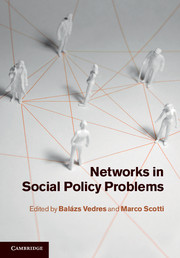Book contents
- Frontmatter
- Contents
- List of contributors
- Acknowledgements
- 1 Introduction
- Part I Information, collaboration, innovation: the creative power of networks
- Part II Influence, capture, corruption: networks perspectives on policy institutions
- 6 Modes of coordination of collective action: what actors in policy-making?
- 7 Why skewed distributions of pay for executives is the cause of much grief: puzzles and few answers (so far)
- 8 Networks of institutional capture: a case of business in the State apparatus
- 9 The social and institutional structure of corruption: some typical network configurations of corruption transactions in Hungary
- Part III Crisis, extinction, world system change: network dynamics on a large scale
- References
- Index
8 - Networks of institutional capture: a case of business in the State apparatus
from Part II - Influence, capture, corruption: networks perspectives on policy institutions
Published online by Cambridge University Press: 05 September 2012
- Frontmatter
- Contents
- List of contributors
- Acknowledgements
- 1 Introduction
- Part I Information, collaboration, innovation: the creative power of networks
- Part II Influence, capture, corruption: networks perspectives on policy institutions
- 6 Modes of coordination of collective action: what actors in policy-making?
- 7 Why skewed distributions of pay for executives is the cause of much grief: puzzles and few answers (so far)
- 8 Networks of institutional capture: a case of business in the State apparatus
- 9 The social and institutional structure of corruption: some typical network configurations of corruption transactions in Hungary
- Part III Crisis, extinction, world system change: network dynamics on a large scale
- References
- Index
Summary
Businesses of all kinds usually try to participate in the regulation of their own activities as much as they can. One way of participating in this regulatory activity is to exercise control on State institutions which solve conflicts among businesses and discipline entrepreneurs. This participation can lead to institutional capture. In this chapter we describe and show the contribution of network analysis in measuring the level of institutional capture in a specific case. We analyze a network of business people acting as lay judges in a judicial institution, the main first-level commercial court in France. This court handles commercial litigation as well as bankruptcies. Courts are not static institutions making atemporal and purely rational decisions. They are contested terrain, the object of broader conflicts that occur outside courthouses. We use a longitudinal study of advice networks among these 240 lay judges at the Commercial Court of Paris (CCP) – judges who are elected by their business community at the local chamber of commerce – to examine a few characteristics of such an institutional capture, in particular an invisible mechanism through which the banking industry manages to dominate this court. Results illustrate the value of network studies for a renewed attention to the inner workings of institutions and for the protection of public interest in the regulation of capitalist economies, in which boundaries between private and public sectors are blurred.
Joint governance and institutional capture
Business usually tries as much as it can to participate in the governance of its markets. In this chapter, we look at an extreme case of how business gets organized, collectively, to do so by capturing a judicial institution. The case is that of French commercial courts, a four and a half century-old institution. In France, the State has long been sharing its own judiciary power with the local business community. Business succeeded in 1563 in negotiating what could be called a “joint governance” agreement with public authorities: this agreement created a special jurisdiction for commerce in which judges are lay, voluntary judges, i.e. elected business people who are not remunerated for the job. French commercial courts are truly judicial, first-level courts.
- Type
- Chapter
- Information
- Networks in Social Policy Problems , pp. 143 - 155Publisher: Cambridge University PressPrint publication year: 2012

